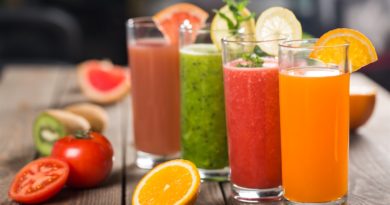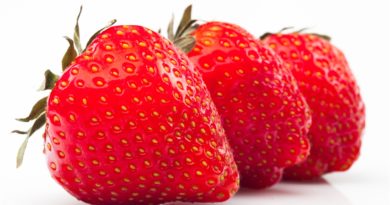12 Toxic Chemicals That Make You Fat
A review of the scientific literature shows that we are surrounded by obesogenic substances, that promote obesity. It is very difficult to avoid them because we can not stop breathing on the street or in the interior spaces we visit.
They are one more factor that influences your health but does not absolutely condition it. We can control its effect by reducing exposure to them as much as possible and not adding other factors that also contribute to inflammation and obesity. In this article, you will discover some of these chemicals and the ways to avoid them.
1. Pesticides and dioxins
They are persistent organic pollutants (POPs) that degrade very slowly in the environment and tend to accumulate in the fatty tissues of organisms. Among them are organochlorine pesticides and industrial waste such as PCBs and dioxins.
POPs are precipitated from the air to pastures and crops. Cows and other animals accumulate them in their body and transfer them to milk. Therefore, food is their main entry into the body. As they are fat-soluble, the most contaminated are the meat of mammals, fatty fish and whole milk products.
How to avoid them?
Avoid foods of animal origin and opt for pesticide-free foods.
2. Phthalates and bisphenols
They are compounds that are added to plastics to confer properties.
- Phthalates: they are found in PVC plastic (polyvinyl chloride), soft plastics and in the aromas that are added to cosmetic and hygiene products.
- Bisphenols: they are found in polycarbonate plastic (they provide transparency and hardness), in epoxy resins (among other things, they cover the inside of metal cans) and in thermal printing papers (tickets).
How to avoid them?
- Avoid plastic in general and cans of preserves. As containers, it resorts to glass and steel.
- In cosmetics, choose products with natural or ecological certification (Ecocert, Cosmos, BDIH or ICEA).
3. Parabens
They are synthetic substances derived from petroleum that are used as preservatives. The most frequent in the lists of ingredients of the labels are:
- Methylparaben (E-218)
- Ethylparaben (E-214)
- Propylparaben (E-216)
- Butylparaben
They are found in food and in all kinds of cosmetic products and personal hygiene. They are also added to medications.
How to avoid them?
Many cosmetic manufacturers already avoid these preservatives. Search the label for statements such as "paraben free" or "paraben free". Certified natural or organic products do not contain them.
4. PFOA and PFOS
Perfluorooctanoic acid (PFOA) can cover surfaces with a plastic film. Perfluorooctanesulfonic acid (PFOS) is used in anti-stain and water repellent products.
They can be found in pans and other non-stick cooking utensils. They are also found in waterproof clothing and footwear, electric cables and fire-fighting foam.
How to avoid them?
Use iron, steel or ceramic kitchenware. Notice that the label says that the product is free of PFOA and PFOS.
5. Volatile organic compounds
They are natural or artificial hydrocarbons that appear in a gaseous state at room temperature or that are very volatile. The most frequent are benzene, toluene, nitrobenzene, formaldehyde, chlorobenzene, xylene, acetone and tetrachlorethylene or perchlorethylene.
Most are released into the air by burning gasoline, wood, coal or natural gas. They are also emitted by solvents, paints, moth repellents and air fresheners, among other products.
How to avoid them?
- Avoid all types of products that emit a strong smell and that you can not attribute to a natural substance.
- Glued products, plywood and other articles that use adhesives and lacquers are usually emitters of these compounds.
- Choose natural and simple materials.
6. Benzophenone
It is a crystalline white substance, insoluble in water and with the smell of roses that acts as a filter of ultraviolet radiation.
It is found in solar creams with filters. Sometimes it is used in perfumes and soaps to prevent light from degrading them. And it is also added to plastics to protect the product contained in the sun.
How to avoid them?
Use natural or ecological sunscreens with mineral filters.
7. Stannane
They are organometallic compounds with carbon and tin bonds that are toxic to insects and eliminate fungi.
They are used in the production of food, textile and paper goods, wood preservatives and additives in plastics (PVC and polyurethane), in silicones, in antifungal paints or in refrigeration systems. They are often found in house dust. Some of the most used are TBT and TPT (a fungicide and insecticide).
How to avoid them?
- Avoid products with "antifungal" treatments.
- Choose untreated natural materials and, if possible, with ecological certification.
8. Reactive oxygen species
They are pollutants among which are peroxides, superoxides and hydroxyl radicals. They are produced naturally by the metabolism of living beings, but they also occur in combustion processes.
They are often part of industrial fumes.
How to avoid them?
- Avoid contaminated areas.
- Strengthen your defenses by obtaining vitamins A (beta carotene), C and E, and antioxidants present in plant foods (green tea, berries, legumes, fruits…)
9. Butylated hydroxytoluene
It is the additive E-321, a widely used food preservative. It is a synthetic substance, derived from petroleum, which prevents the rancidity of fats. It is usually accompanied by another additive, butylated hydroxyanisole (BHA, E-320).
It is among the ingredients of ultra-processed products such as fried and baked goods. Also in prepared soups, marzipan, purées and even chewing gum. On the other hand, it can be in cosmetics and products for home hygiene.
How to avoid them?
- Avoid processed foods.
- Choose foods with ecological certification.
10. Polybrominated diphenyl ethers
Polybrominated diphenyl ethers (or PBDEs) are used as flame retardants. In addition to being endocrine disruptors, they have been associated with alterations in the immune system, blood and liver.
Covers components of electronic devices, including appliances, construction materials, plastics, furniture, mattresses, textiles (carpets…).
How to avoid them?
- In many occasions they are used by legal obligation. To avoid their release into the environment, it is convenient to take the articles that contain it to recycling plants (green or clean points).
- Ventilate your home daily, don't forget about regular vacuuming and removing dust.
11. Organophosphorus
They are compounds used mainly in the control of pests. Most insecticides fall into this category.
They contaminate conventionally produced foods and are in the composition of many household insecticides.
How to avoid them?
- Choose organic foods.
- Use natural means to control insects.
12. Heavy metals
Mercury, cadmium, arsenic or lead outside ecosystems become toxic pollutants.
They are emitted into the air by industrial chimneys and incinerators. Then they rush on crops and pollute water and food.
Compact fluorescents contain mercury.
How to avoid them?
- Avoid large fatty fish (tuna or swordfish) as they accumulate high doses of mercury in their tissues. It is convenient to avoid them, especially during pregnancy and lactation.
- Prefer LEDs to fluorescent lamps and take them to an eco waste after their service life.




